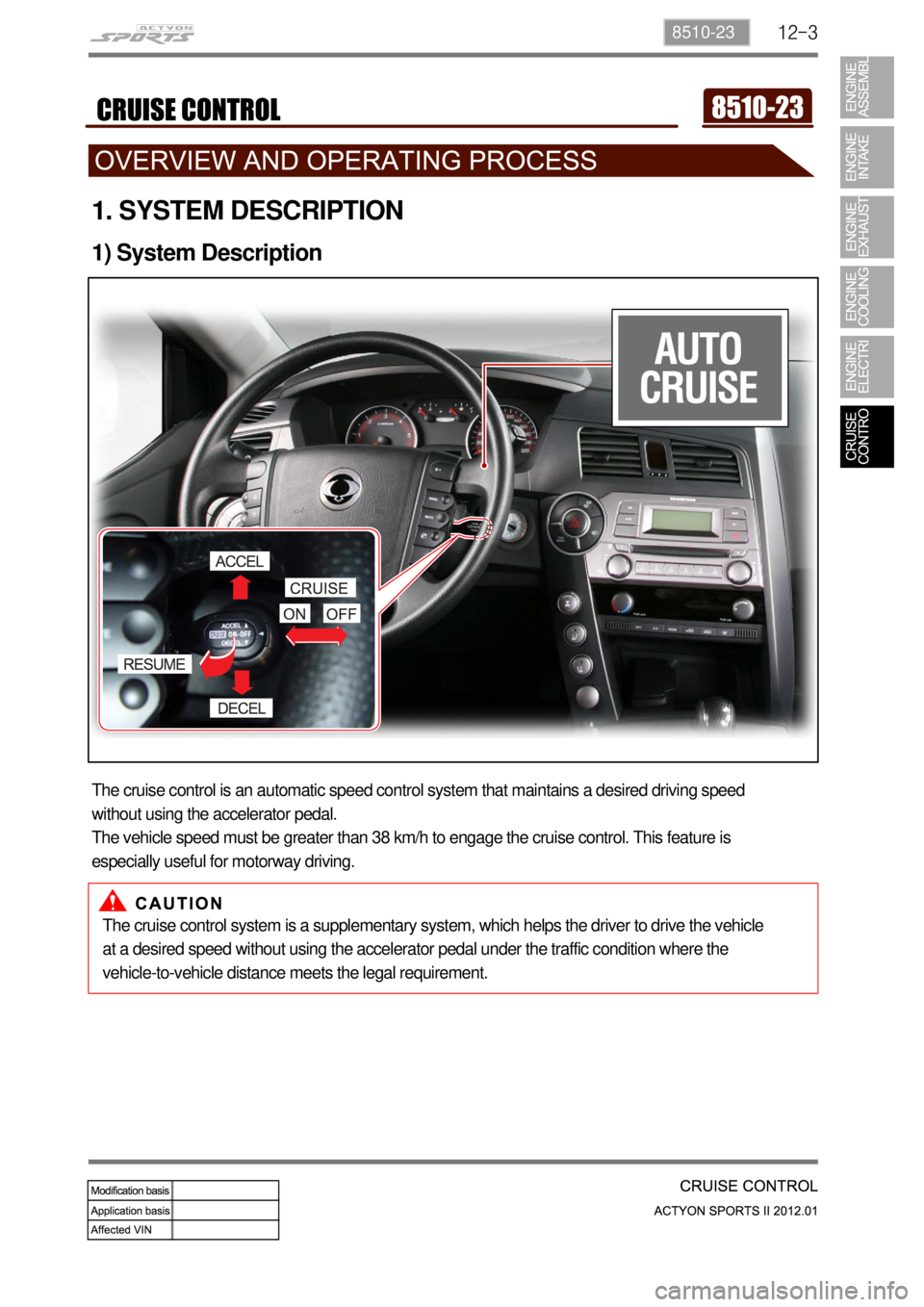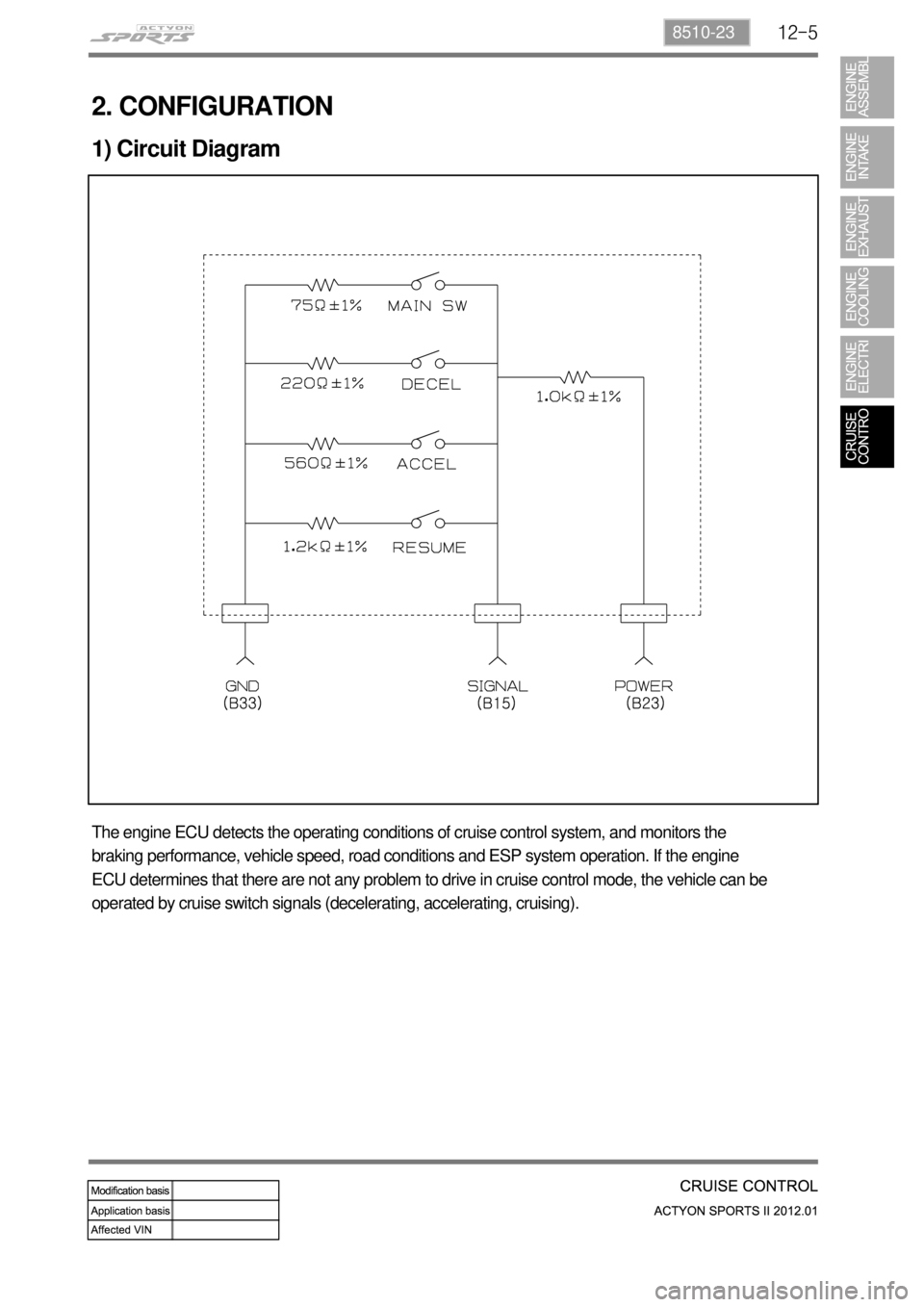SSANGYONG NEW ACTYON SPORTS 2012 Service Manual
Manufacturer: SSANGYONG, Model Year: 2012, Model line: NEW ACTYON SPORTS, Model: SSANGYONG NEW ACTYON SPORTS 2012Pages: 828, PDF Size: 91.28 MB
Page 391 of 828

05-4
2) Ignition System (Cont'd)
Page 392 of 828

05-51452-01
1. DESCRIPTION AND OPERATION
1) Battey
The sealed battery is standard on all cars. There are no vent plugs in the cover.
The battery is completely sealed, except for two small vent holes in the sides.
These vent holes allow the small amount of gas produced in the battery to escape.
The battery has the following advantages over conventional batteries:
No water addition for the life of the battery.
Overcharge protection. If too much voltage is applied to the battery, it will not accept as much
current as a conventional battery.
In a conventional battery, the excess voltage will still try to charge the battery, leading
to gassing, which causes liquid loss.
Not as liable to self-discharge as a conventional battery. This is particularly important when a
battery is left standing for long periods of time.
More power available in a lighter, smaller case. ·
·
·
·
The battery has three major functions in the electrical system.
First, the battery provides a source of energy for cranking the engine.
Second, the battery acts as a voltage stabilizer for the electrical system. Finally, the battery
can, for a limited time, provide energy when the electrical demand exceeds the output of the
generator.
2) Ratings
<0068004700890088009b009b008c009900a00047008f0088009a0047009b009e0096004700990088009b00900095008e009a00610047004f005800500047008800470099008c009a008c0099009d008c0047008a008800970088008a0090009b00a0004700
990088009b00900095008e0047008b008c009a0090008e0095>ated at 27°C(80°F), which is the
time a fully charged battery will provide 25 amperes of current flow at or above 10.5 volts (2) a
cold cranking am
p rating determined under testing at -18°C(0°F), which indicates the cranking
load capacity. ▶
(1)Reserve Capacity
The reserve capacity (RC) is the maximum length of time it is possible to travel at night with the
minimum electrical load and no generator output. Expressed in minutes, the RC rating is the time
required for a fully charged battery, at a temperature of 27°C(80°F) and being discharged at a
current of 25 amperes, to reach a terminal voltage of 10.5 volts.
Page 393 of 828

05-6
(2) Cold Cranking Amperage
The cold cranking amperage test is expressed at a battery temperature of -18°C(0°F).
The current rating is the minimum amperage, which must be maintained by the battery for 30
seconds at the specified temperature, while meeting a minimum voltage requirement of 7.2 volts.
This rating is a measure of cold cranking capacity.
The battery is not designed to last indefinitely. However, with proper care, the battery will provide
many years of service. If the battery tests well, but fails to perform satisfactorily in service for no
apparent reason, the following factors may point to the cause of the trouble:
Vehicle accessories are left on overnight.
Slow average driving speeds are used for short periods.
The vehicle's electrical load is more than the generator output, particularly with the addition of
aftermarket equipment.
Defects in the charging system, such as electrical shorts, a slipping generator belt, a faulty
generator, or a faulty voltage regulator.
Battery abuse, including failure to keep the battery cable terminals clean and tight or a loose
battery hold-down clamp.
Mechanical problems in the electrical system, such as shorted or pinched wires. ·
·
·
·
·
·
3) Charging Time Required
The time required to charge a battery will vary depending upon the following factors:
Size of Battery - A Completely discharged large heavy-duty battery required more than twice
the recharging time as a completely discharged small passenger car battery. ▶
<007b008c00940097008c00990088009b009c0099008c00470054004700680047009300960095008e008c00990047009b00900094008c0047009e00900093009300470089008c00470095008c008c008b008c008b0047009b00960047008a008f0088009900
8e008c00470088009500a0004700890088009b009b008c0099>y at -18°C(0°F) than at
27°C(80°F).
When a fast charger is connected to a cold battery, the current accepted by the battery will be
very low at first.
The battery will accept a higher current rate as the battery warms. ▶
Charger Capacity - A charger which can supply only 5 amperes will require a much longer
charging period than a charger that can supply 30 amperes or more. ▶
State-of-Charge - A completely discharged battery requires more than twice as much charge
as a onehalf charged battery.
Because the electrolyte is nearly pure water and a poor conductor in a completely discharged
battery, the current accepted by the battery is very low at first. Later, as the charging current
causes the electrolyte acid content to increase, the charging current will likewise increase. ▶
Page 394 of 828

05-71452-01
4) Charging a Completely Discharged Battery (Off the Vehicle)
Unless this procedure is properly followed, a perfectly good battery may be needlessly replaced.
The following procedure should be used to recharge a completely discharged battery:
Measure the voltage at the battery terminals with an accurate voltmeter.
If the reading is below 10 volts, the charge current will be very low, and it could take some
time before the battery accepts the current in excess of a few milliamperes.
Refer to "Charging Time Required" in this section, which focuses on the factors affecting
both the charging time required. Such low current may not be detectable on ammeters
available in the field.
Set the battery charger on the high setting. 1.
2.
Continue to charge the battery until the charge current is measurable. Battery chargers vary
in the amount of voltage and current provided. The time required for the battery to accept a
measurable charger current at various voltages may be as follows: 3.
If the charge current is not measurable at the end of the above charging times, the battery
should be replaced.
If the charge current is measurable during the charging time, the battery is good, and
charging should be completed in the normal manner. ·
·
If the charge current is still not measurable after using the charging time calculated by the
above method, the battery should be replaced. ·
It is important to remember that a completely discharged battery must be recharged for a
sufficient number of ampere hours (AH) to restore the battery to a usable state.
Page 395 of 828

05-8
5) Jump Starting Procedure
Position the vehicle with the charged battery so that the jumper cables will reach from the
charged battery to the battery that requires charging.
Turn off the ignition, all the lights, and all the electrical loads in both vehicles.
Leave the hazard flasher on if jump starting where there may be other traffic and any other
lights needed for the work area.
Apply the parking brake firmly in both vehicles. 1.
2.
3.
4.
Shift an automatic transmission to PARK. 5.
Clamp one end of the first jumper cable to the positive terminal on the booster battery. Make
sure it does not touch any other metal parts.
Clamp the other end of the same cable to the positive terminal on the discharged battery.
Never connect the other end to the negative terminal of the discharged battery. 6.
7.
Clamp one end of the second cable to the negative terminal of the booster battery.
Make the final connection to a solid engine ground, such as the engine lift bracket at least 450
millimeters (18 inches) from the discharged battery.
Start the engine of the vehicle with the good battery.
Run the engine at a moderate speed for several minutes.
Then start the engine of the vehicle with the discharged battery.
Remove the jumper cables by reversing the above sequence exactly, removing the negative
cable from the vehicle with the discharged battery first.
While removing each clamp, take care that it does not touch any other metal while the other
end remains attached. 8.
9.
10.
11.
12.In order to avoid damaging the vehicle make sure the cables are not on or near pulleys, fans,
or other parts that will move when the engine starts.
In order to avoid injury, do not use cables that have loose or missing insulation.
Page 396 of 828

05-91452-01
6) Alternator
Alternators are equipped with internal regulators.
Unlike three-wire generators, the alternator may be used with only two connections: battery
positive and an "D+" terminal to the charge indicator lamp.
As with other charging systems, the charge indicator lamp lights when the ignition switch is turned
to RUN, and goes out when the engine is running.
If the charge idicator is on with the engine running, a charging system defect is indicated. This
indicator light will glow at full brilliance for several kinds of defects as well as when the system
voltage is too high or too low.
The regulator voltage setting varies with temperature and limits the system voltage by controlling
rotor field current.
Achieve correct average field current for proper system voltage control by varying the on-off time.
At high speeds, the on-time may be 10 percent and the off-time 90 percent.
At low speeds, with high electrical loads, the on-time may be 90 percent and the off-time 10
percent.
7) Charging System
Generators use a new type of regulator that incorporates a diode trio.
A Delta stator, a rectifier bridge, and a rotor with slip rings and brushes are electrically similar
to earlier generators.
A conventional pulley and fan are used.
There is no test hole.
8) Starter
Wound field starter motors have pole pieces, arranged around the armature, which are energized
by wound field coils.
Enclosed shift lever cranking motors have the shift lever mechanism and the solenoid plunger
enclosed in the drive housing, protecting them from exposure to dirt, icy conditions, and
splashes.
In the basic circuit, solenoid windings are energized when the switch is closed.
The resulting plunger and shift lever movement causes the pinion to engage the engine flywheel
ring gear.
The solenoid main contacts close. Cranking then takes place.
When the engine starts, pinion overrun protects the armature from excessive speed until the
switch is opened, at which time the return spring causes the pinion to disengage.
To prevent excessive overrun, the switch should be released immediately after the engine starts.
Page 397 of 828

05-10
9) Starting System
The engine electrical system includes the battery, the ignition, the starter, the generator, and all
the related wiring.
Diagnostic tables will aid in troubleshooting system faults. When a fault is traced to a particular
component, refer to that component section of the service manual.
The starting system circuit consists of the battery, the starter motor, the ignition switch, and all the
related electrical wiring.
All of these components are connected electrically.
Page 398 of 828

12-38510-23
1. SYSTEM DESCRIPTION
1) System Description
The cruise control is an automatic speed control system that maintains a desired driving speed
without using the accelerator pedal.
The vehicle speed must be greater than 38 km/h to engage the cruise control. This feature is
especially useful for motorway driving.
The cruise control system is a supplementary system, which helps the driver to drive the vehicle
at a desired speed without using the accelerator pedal under the traffic condition where the
vehicle-to-vehicle distance meets the legal requirement.
Page 399 of 828

12-4
2) Traffic Conditions for Using Cruise Control
Use the cruise control system only when the traffic is not jammed, driving on motorways or
highways where there is no sudden change in the driving condition due to traffic lights, pedestrian,
etc.
Improper use of the cruise control could be dangerous.
- Do not use on winding roadsyy .
- Do not use in heavy traffic.
- Do not use on slippery, wet roads.
This could result in a loss of control, collision, and/or personal injuries.
Page 400 of 828

12-58510-23
2. CONFIGURATION
1) Circuit Diagram
The engine ECU detects the operating conditions of cruise control system, and monitors the
braking performance, vehicle speed, road conditions and ESP system operation. If the engine
ECU determines that there are not any problem to drive in cruise control mode, the vehicle can be
operated by cruise switch signals (decelerating, accelerating, cruising).